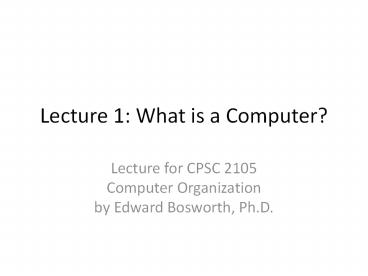Lecture 1: What is a Computer? PowerPoint PPT Presentation
1 / 21
Title: Lecture 1: What is a Computer?
1
Lecture 1 What is a Computer?
- Lecture for CPSC 2105Computer Organizationby
Edward Bosworth, Ph.D.
2
An Older Computer
- The figure at right is an older computer, called
a PDP-11/20. - It was designed in the early 1970s.
- It shows the computer, with front-panelswitches,
and a paper tape reader. - User interaction was via a teletype.
- Basically, all one got was bare iron the
hardware and very little software.
3
An ASR-33 Teletype
4
A Modern Computer as a System
- A modern computer must be seen as a complete
system software hardware. - The hardware and software must be designed as a
complete system. - Software includes the operating system and
compilers to convert higher level languages to
the primitive assembly language.
5
User Experience of a Computer
- There are a number of factors affecting the user
experience of a modern computer. - 1. The choice of operating system.
- 2. The GUI (graphical user interface).
- 3. The physical size of the computer itself.
- What is not a factor includes the detailed design
of the CPU and other hardware.
6
Sample ComputerMy Wifes Netbook.
7
Some Properties of the Computer
- It is approximately 11 inches by 7.5 inches.
When closed it is a bit less than one inch
thick. This CPU model was introduced in the
second quarter of 2010. It is made in China. - The CPU is an Intel Core i3330UM, which operates
at 1.2 GHz. It is described by Intel as an
Ultra Low Voltage dualcore processorfor small
and light laptops.
8
More Properties of the Computer
- It has a threelevel cache. Each of the two
cores has a L1 (Level 1) cache (likely a
32kilobyte split cache, with 16 KB for
instructions and 16 KB for data), and a 512 KB L2
cache. The two cores share a common 3 MB L3
cache. - The computer has 2 GB (2,048 MB) of DDR3 memory.
- The computer has a 256 GB hard disk and two USB
ports that can be used for USB flash drives. - The display is a 1366 by 768 LED LCD.
- The computer has a builtin GSM card for access
to the global Internet through the ATT network.
9
The GUI
10
The Computer As An Appliance
- Most users of a computer view it as an appliance
just a machine that does things. - Provides e-mail
- Runs Facebook and other social media
- Runs applications, such as MS-Word, etc.
- The computer is seen as a complete system,
without thought of its piece parts. - This is one of our great achievements in CS
11
The Computer as anEngine for High-Level Languages
- This is the view of many programmers. It also is
quite valid. - The computer allows a Java program to run, accept
input and produce output. - This is also a valid approach to
understandingcomputers.
12
Computers from the Bottom Up
- At the lowest level of concern to this course,
the computer is characterized by its ISA, the
Instruction Set Architecture. - The primitive instructions that operatethe CPU.
- The general-purpose registers available foruse
by the programmer. - The details of the I/O system.
13
Another View of the Computer
- The Operating System provides services thatuse
and augment the low level ISA
14
IBM System/370 Assembler
- Here is some code, with System Calls in Red
- PUT PRINTER,PRHEAD
- GET FILEIN,RECORDIN
- LOOP MVC DATAPR,RECORDIN
- PUT PRINTER,PRINT
- GET FILEIN,RECORDIN
- B LOOP
15
Moores Law
- Gordon Moore, one of the founders of the Intel
Corporation, made an observation about the
density of transistors on a computer chip. - He noted that the count would double about every
18 months or two years. - This observation has held true for about four
decades, so it is now called a law.
16
Graph of Transistor Count
17
Picture Showing Moores Law
18
The Power Wall
19
The Power Wall (Part 2)
20
The C/C Language
- We shall write a few small programs and use a
debugger to examine the internal structures. - The language will be the older C language, with a
few C features. We shall use the C compiler,
which is more convenient. - This will be C without objects.
21
Sample C/C Program

